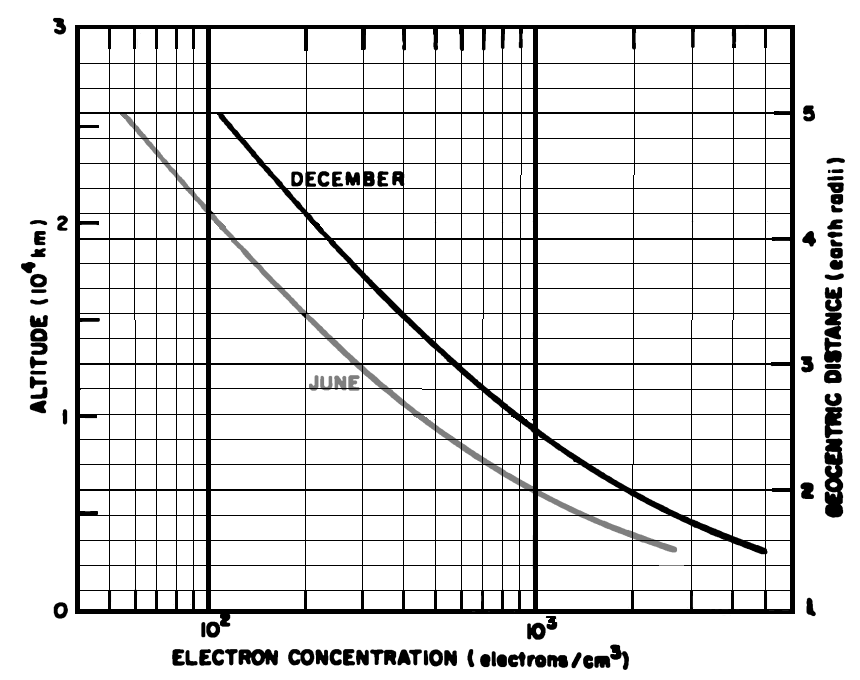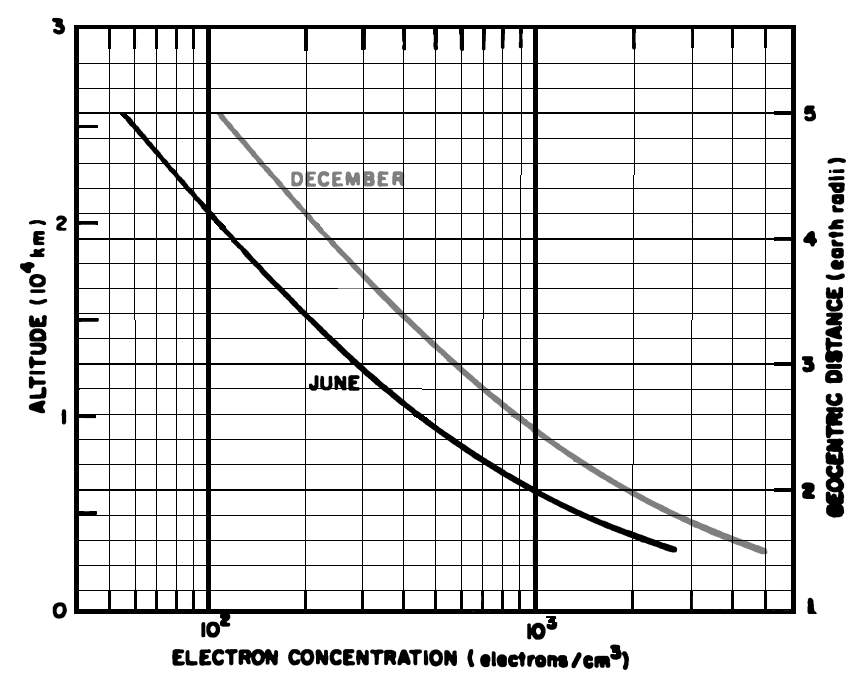Ionosphere and Magnetosphere Density and Charge
The launch loop operates at the bottom fringe of the ionosphere, but launches vehicles into it and through it. Tethers may be used for apogee insertion, and these tethers must contend with drag and lightning/whistler conduction effects in the ionosphere and the magnetosphere. If dynamic structure platforms are not used for a hypothetical space elevator, insulating the tether from the ground, then conduction through the space elevator tether may lead to failures.
December
L shell |
Equatorial |
Latitude |
Footprint |
Electron |
Debye |
Conductivity |
||
|
Altitude km |
degrees |
km/km |
density |
length |
Para |
Perp |
|
1.0 |
0.0 |
0.0 |
INF |
/m3 |
m |
S/m |
S/m |
|
1.05 |
318.9 |
12.6 |
2.13 |
- |
- |
- |
- |
|
1.1 |
637.8 |
17.5 |
1.44 |
- |
- |
- |
- |
|
1.2 |
1275.6 |
24.1 |
0.93 |
- |
- |
- |
- |
|
1.3 |
1913.4 |
28.7 |
0.70 |
- |
- |
- |
- |
|
1.4 |
2551.2 |
32.3 |
0.56 |
- |
- |
- |
- |
|
1.5 |
3189.0 |
35.3 |
0.47 |
5.0E6 |
1.19 |
- |
- |
|
1.6 |
3826.8 |
37.8 |
0.40 |
4.1E6 |
1.32 |
- |
- |
|
1.8 |
5102.4 |
41.8 |
0.31 |
2.8E6 |
1.59 |
- |
- |
|
2.0 |
6378.0 |
45.0 |
0.27 |
1.9E6 |
1.93 |
- |
- |
|
2.2 |
7653.6 |
47.6 |
0.25 |
1.3E6 |
2.34 |
- |
- |
|
2.4 |
8929.2 |
49.8 |
0.21 |
1.1E6 |
2.54 |
- |
- |
|
2.6 |
10204.8 |
51.7 |
0.18 |
8.8E5 |
2.84 |
- |
- |
|
2.8 |
11480.4 |
53.3 |
0.15 |
7.0E5 |
3.19 |
- |
- |
|
3.0 |
12756.0 |
54.7 |
0.12 |
5.4E5 |
3.63 |
- |
- |
|
3.5 |
15945.0 |
57.7 |
0.09 |
4.0E5 |
4.22 |
- |
- |
|
4.0 |
19134.0 |
60.0 |
0.07 |
2.4E5 |
5.45 |
- |
- |
|
4.5 |
22323.0 |
61.9 |
0.06 |
1.7E5 |
6.48 |
- |
- |
|
5.0 |
25512.0 |
63.4 |
0.05 |
1.1E5 |
8.05 |
- |
- |
|
5.5 |
28701.0 |
64.8 |
0.04 |
- |
- |
- |
- |
|
6.0 |
31890.0 |
65.9 |
0.04 |
- |
- |
- |
- |
|
June
L shell |
Equatorial |
Latitude |
Footprint |
Electron |
Debye |
Conductivity |
||
|
Altitude km |
degrees |
km/km |
density |
length |
Para |
Perp |
|
1.0 |
0.0 |
0.0 |
INF |
/m3 |
m |
S/m |
S/m |
|
1.5 |
3189.0 |
35.3 |
0.47 |
2.8E6 |
1.59 |
- |
- |
|
1.6 |
3826.8 |
37.8 |
0.40 |
2.1E6 |
1.84 |
- |
- |
|
1.8 |
5102.4 |
41.8 |
0.31 |
1.3E6 |
2.34 |
- |
- |
|
2.0 |
6378.0 |
45.0 |
0.27 |
9.5E5 |
2.74 |
- |
- |
|
2.2 |
7653.6 |
47.6 |
0.25 |
6.5E5 |
3.31 |
- |
- |
|
2.4 |
8929.2 |
49.8 |
0.21 |
5.2E5 |
3.70 |
- |
- |
|
2.6 |
10204.8 |
51.7 |
0.18 |
4.2E5 |
4.12 |
- |
- |
|
2.8 |
11480.4 |
53.3 |
0.15 |
3.6E5 |
4.45 |
- |
- |
|
3.0 |
12756.0 |
54.7 |
0.12 |
2.8E5 |
5.05 |
- |
- |
|
3.5 |
15945.0 |
57.7 |
0.09 |
2.0E5 |
5.97 |
- |
- |
|
4.0 |
19134.0 |
60.0 |
0.07 |
1.2E5 |
7.71 |
- |
- |
|
4.5 |
22323.0 |
61.9 |
0.06 |
8.0E4 |
9.44 |
- |
- |
|
5.0 |
25512.0 |
63.4 |
0.05 |
4.7E4 |
12.3 |
- |
- |
|
The Debye length is based on 1250K and electron charge only, and suitable for fast processes. In equilibrium, the ions are at the same temperature contribute, and the lengths are divided by sqrt(2). ???
Electron density estimated from Figure 2-7, a graph on page 34 in the chapter by W.B. Hansen, in The Satellite Environment Handbook, Francis S. Johnson Editor, Stanford University Press 1965. The figure references "The Use of Nose Whistlers in the Study of the Outer Ionosphere" by R.L. Smith, Technical Report No. 6, Contract AF18(603)-126, Stanford Electronics Laboratories, 1960. I need a better tabular or formula source, perhaps below:
IRI - International Reference Ionosphere http://modelweb.gsfc.nasa.gov/ionos/iri.html
Ionospheric Conductivity http://wdc.kugi.kyoto-u.ac.jp/ionocond/exp/icexp.html
The Satellite Environment Handbook


